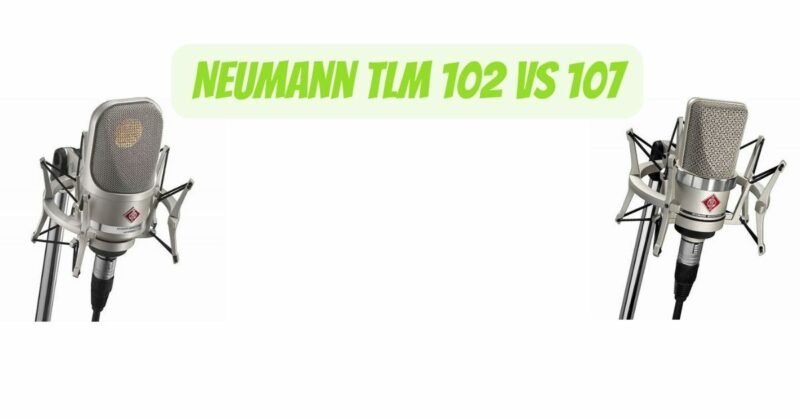Neumann is a renowned name in the audio industry, known for producing high-quality studio microphones that deliver exceptional sound reproduction. In this article, we will compare two popular offerings from Neumann: the TLM 102 and the TLM 107. Both microphones belong to Neumann’s TLM series and offer distinct features and sonic characteristics. By examining their design, sound quality, features, and applications, we aim to help you understand the differences and make an informed decision on which microphone is best suited for your recording needs.
Design and Build Quality:
Both the Neumann TLM 102 and the TLM 107 exhibit the impeccable build quality that Neumann is known for. The TLM 102 features a compact and sleek design, with a matte black finish and a distinctive grille. It has a solid metal construction that exudes durability and reliability. The TLM 102’s compact size makes it suitable for various recording environments, including home studios and professional recording facilities.
In contrast, the TLM 107 has a larger and more traditional microphone design. It features a classic Neumann nickel finish with a rugged grille that gives it a vintage charm. The TLM 107 is built with precision and attention to detail, showcasing Neumann’s commitment to quality. It has a robust metal construction and exudes a sense of durability and longevity.
Sound Quality and Performance:
When it comes to sound quality, both the TLM 102 and the TLM 107 offer exceptional performance, but they have different sonic characteristics that cater to different recording applications.
The TLM 102 is known for its transparent and detailed sound reproduction. It features a large-diaphragm condenser capsule that captures vocals and instruments with exceptional clarity and accuracy. The TLM 102 has a linear frequency response, providing a balanced sound across the entire audio spectrum. It excels in capturing vocals, acoustic instruments, and voiceover work, delivering pristine recordings that capture the nuances of the source material.
On the other hand, the TLM 107 offers a more versatile sonic character. It features a switchable polar pattern, allowing you to choose between omnidirectional, cardioid, and figure-of-eight patterns. This versatility makes the TLM 107 suitable for a wide range of recording scenarios, from vocals and instruments to room ambiance and ensemble recording. The TLM 107’s sound is characterized by a smooth frequency response, warm midrange, and extended low-end, providing a rich and full-bodied sound.
Features and Functionality:
The TLM 102 and the TLM 107 come equipped with features that enhance their functionality and usability.
The TLM 102 is a straightforward microphone with a fixed cardioid polar pattern. It focuses on capturing sound from the front while rejecting off-axis noise. It has a high maximum SPL handling capability, making it suitable for recording loud sources without distortion. The TLM 102 requires 48V phantom power to operate and can be easily integrated into any professional audio setup.
In contrast, the TLM 107 offers greater versatility with its switchable polar patterns. It allows you to adapt the microphone to different recording situations, whether you need to capture a single source or a multi-person conversation. The TLM 107 also features a low-cut filter and a selectable pre-attenuation pad, allowing you to tailor the microphone’s response to specific recording scenarios. Additionally, the TLM 107 includes three different filter presets that can be accessed via switches on the microphone body, providing further control over the sound.
Applications and Versatility:
Both the TLM 102 and the TLM 107 find their applications in various recording scenarios, but they excel in different areas.
The TLM 102’s transparent and detailed sound reproduction makes it an excellent choice for recording vocals, acoustic instruments, and voiceover work. Its compact size and uncomplicated design make it ideal for home studios, podcasting, and content creation.
The TLM 107’s versatility and switchable polar patterns make it suitable for a wider range of recording applications. It can handle vocals, instruments, ensembles, and even capturing room ambience. The TLM 107’s ability to adapt to different recording situations makes it a valuable tool in professional studios and broadcast environments.
Price and Value:
It’s important to consider the price and value of these microphones when making a purchasing decision. The TLM 107 is positioned as a higher-end microphone and is generally priced higher than the TLM 102. The TLM 107’s versatility, advanced features, and its association with the Neumann brand justify its higher price point. It is an investment for professionals and audio enthusiasts who demand top-notch sound quality and versatility.
The TLM 102, on the other hand, offers excellent value for its price. It delivers exceptional sound quality and the reliability of the Neumann brand at a more affordable price compared to the TLM 107. The TLM 102 is an accessible option for musicians, home studios, and content creators who want to elevate their audio recordings without breaking the bank.
Conclusion:
In the Neumann TLM 102 vs. TLM 107 comparison, both microphones offer exceptional sound quality, build quality, and versatility. The TLM 102 impresses with its transparent and detailed sound reproduction, compact design, and affordability. It is an excellent choice for vocals, acoustic instruments, and voiceover work.
The TLM 107 stands out with its versatile switchable polar patterns, warm and full-bodied sound, and advanced features. It offers greater flexibility and is suitable for a wide range of recording applications, including vocals, instruments, ensembles, and room ambience.
Consider your specific recording needs, budget, and preferences in terms of design, sound characteristics, and features when making your decision. Both the Neumann TLM 102 and the TLM 107 are outstanding microphones that can elevate your recordings to a professional level.


